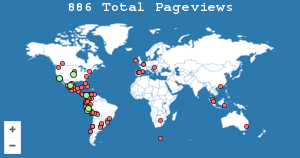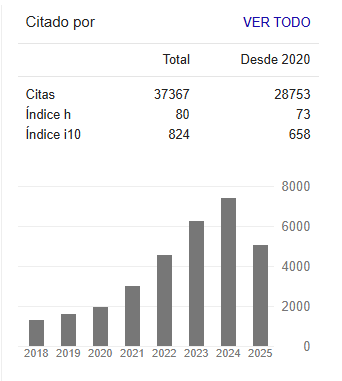Validation of an instrument to measure the improvement of individual performance in small and medium-sized companies in Mexico
Resumen
The present paper analyzes psychometric properties of a self-made instrument to measure individual performance based on Gilbert’s BEM. This research is quantitative, descriptive, correlational, causal; cross-sectional, using exploratory factor analysis and principal component analysis with Varimax orthogonal rotation. Empirical support was obtained by using a randomly stratified sample of 297 Mexican companies of Sonora State. The questionnaire – named DOPT- proved adequate to assess relevant organizational factors of human performance that could guide organizational performance policies accordingly. Its 40 items assess organizational level achieved in the following areas: Aims and objectives, Feedback, Task support, Incentives, Knowledge/Competences, Context, Sanctions, and Work processes. Psychometric properties results are commented in the light of commented literature about current overall organizational assessment and corporate longevity. In addition, organizational performance areas are discussed under a timing perspective defining mapping and tracing loops of organizational performance management.
Citas
Bernardez, M.L. (2005). Achieving business success by developing clients and community: lessons from leading companies, emerging economies and a nine-year case study. Performance Improvement Quarterly, 18(3), 37-55.
Bernárdez, M.L. (2009). Desempeño Humano Manual de consultoría. AuthorHouse.
Brethower, D. (2007). Performance analysis. Knowing what to do and how. United States of America and Canada: HRD Press, Inc. & International Society for Performance Improvement.
Burt, G. & Chermack, T.J. (2008). Learning with scenarios: summary and critical issues. Advances in Developing Human Resources, 10(2), 285-295, https://doi.org/10.1177/1523422307313334
Cefis, E. & Marsili, O. (2005). A matter of life and death: Innovation and firm survival. Industrial and Corporate Change, 14(6), 1167-1192, https://doi.org/10.1093/icc/dth081
Chen, H.L. & Lin, Y.L. (2018). Goal orientations, leader-leader exchange, trust, and the outcomes of project performance. International Journal of Project Management, 36(5), 716-729, https://doi.org/10.1016/j.ijproman.2018.03.009
Chermack, T.J., Lynham, S.A. & Van Der Merwe, L. (2006). Exploring the relationship between scenario planning and perceptions of learning organization characteristics. Futures, 38(7), 767-777, https://doi.org/10.1016/j.futures.2005.12.010
Chevalier, R. (2003). Updating the Behavior Engineering Model. Performance Improvement, 42(5), 8-14, https://doi.org/10.1002/pfi.4930420504
Creswell, J.W. (2009). Research Design: Qualitative, Quantitative, and mixed method approaches. United States of America: Sage Publications. Inc.
Crossman, D.C. (2010). Gilbert’s Behavior Engineering Model: Contemporary support for an established theory. Performance Improvement Quarterly, 23(1), 31-52, https://doi.org/10.1002/piq.20074
Cruz, C. C. J., Rojas, G. G. P. y Rivero-Villar, M. J. (2012). Evaluación de la relación aprendizaje organizativo y desempeño organizacional. Un estudio empírico en las empresas de la industria manufacturera que cotizan en la Bolsa Mexicana de Valores. XIII Asamblea General de la Asociación Latinoamericana de Facultades y Escuelas de Contaduría y Administración. [online]http://132.248.164.227/alafec/docs/asambleas/xiii/ponencias/administracion/pdf/AD_18.pdf
De Geus, A.P. (1988). Planning as learning. Harvard Business Review, 66(2), 70-74.
De Geus, A.P. (2002). The living company. Harvard Business School Press.
Del Castillo, C. y Vargas, B. (2009). El proceso de gestión y el desempeño organizacional. Una aproximación a la nueva gestión pública desde el ámbito de los gobiernos locales. http://www.ief.es/documentos/recursos/publicaciones/revistas/107presu_gasto_publico/41-06_FranciscoLongo.pdf
Fabrigar, L.R., Wegener, D.T., MacCallum, R.C. & Strahan, E.R.J. (1999). Evaluating the use of exploratory factor analysis in psychological research. Psychol Methods, 4(3), 272–299. https://doi.org/10.1037/1082-989X.4.3.272
Galadanchi, H. & Bakar, L.J. (2018). A study of factors that support longevity of business enterprises. Journal of Business and Management, 20(1), 53-59.
Gilbert T.F. (2007). Human Competence Engineering worthy performance. Pfeiffer.
Gilbert, T.F. (1978). Human competence: engineering worthy performance. McGraw-Hill.
Hair, J.F., Black, W.C., Babin, B.J., Anderson, R.E. & Tatham, R. (2010). Multivariate data analysis. Pearson ed.
Hernández, S.R., Fernández, C.C., Baptista, L.P. (2014). Metodología de la investigación. (6ª. Ed). McGraw Hill.
Hersey, P. & Chevalier, R. (2006). Situational Leadership and Executive Coaching. In Goldsmith, M., Lyons, L. Coaching for leadership: The practice of leadership coaching from the world’s greatest coaches. 2nd ed. pp. 2636. San Diego, CA: Pfeiffer & Company.
Irlbeck, S. (2008). Human performance technology: an examination of definitions through dependent and independent variables. Performance Improvement Quarterly, 15(2), 84–95, https://doi.org/10.1111/j.1937-8327.2002.tb00251.x
Kim, H.J. (2018). Traking the value of data: Motivation and requirements. Information, 21(2), 745-753.
Mager, R.F. & Pipe, P. (2006). Analyzing Performance Problems: Or, You Really Oughta Wanna. (3rd ed). Center for Effective Performance.
Malacara-Castillo, A.R., Sandoval, G.D & Becerra, M.E. (2013). Identificación de buenas prácticas de gestión empresarial en sociedades cooperativas eco-turísticas en Jalisco, México. International Review of Business Research Papers, 9(2), 109–124.
Mancur, O. (1982). The rise and decline of nations: economic growth, stagflation, and social rigidities. New Haven, CT: Yale University Press.
Nee, V. (1998). Norms and networks in economic and organizational performance. The American Economic Review, 88(2), pp.85-89.
Obeidat, B.Y., Al-Hadidi, A., Tarhini, A. & Masa´deh, R. (2017). Factors affecting strategy implementation: A case study of pharmaceutical companies in the Middle East. Review of International Business and Strategy, 27(3), 386-408. https://doi.org/10.1108/RIBS-10-2016-0065
Oviedo, H. C., & Campo-Arias, A. (2005). Aproximación al uso del coeficiente alfa de Cronbach. Revista Colombiana de Psiquiatría, 34(4), 572-580. http://www.scielo.org.co/scielo.php?script=sci_arttext&pid=S0034-74502005000400009&lng=en&tlng=es.
Pawlowski, C.W. (2000). Comments on the use of propositional logic to examine sustainability concepts. Ecological modelling, 127(2), 207-219. https://doi.org/10.1016/S0304-3800(99)00207-0
Pershing, J.A. (2006). Handbook of Human Performance Technology: Principles Practices Potential. Pfeiffer.
Pierce, W.D.J., Banko K.M., So S. (2003). Positive effects of rewards and performance, standards on intrinsic motivation. Psychological Records, 53(4), 561-78.
Piersol, W. J. & Paris, C. (2007). Human Performance Technology: A Discipline to Improve C2 Concept Development and Analysis. KLETT CONSULTING GROUP VIRGINIA BEACH VA. http://www.dodccrp.org/events/12th_ICCRTS/CD/html/papers/049.pdf
Pil, S. (2012). Validation of key stages of the international society for performance improvement human performance technology model. http://search.proquest.com/docview/929133954?accountid=31361
Queipo, B. y Useche, M. (2002). El desempeño laboral en el departamento de mantenimiento del Ambulatorio la Victoria. Revista de Ciencias Sociales, 8(3), 486-496.
Quintero, N., Africano, N., & Faria, E. (2008). Clima Organizacional y Desempeno Laboral del Personal Empresa Vigilantes Asociados Costa Oriental del Lago. Negotium. Revista de ciencias gerenciales, (9), 33-51. https://www.scirp.org/reference/referencespapers?referenceid=3103825
Rothwell, W.J., Hohne, C.K., King, S.B. (2007). Human performance improvement. Building practitioner competence. A volume in improving human performance. Butterworth-Heinemann. Elsevier Inc.
Rummler, G.A. & Brache, A.B. (1995). Improving performance: how to manage the white space on the organization chart. Jossey-Bass.
Vásquez, T. M. C. (2014). Modelo de Gestión de Desempeño Individual a un Distrito de Riego. (Tesis doctoral). Instituto tecnológico de Sonora. Obregón.
Weitzman, F. & Chermack, T.J. (2013). Success and failure using scenario planning to enhance organisational longevity. International Journal of Technology Intelligence and Planning, 9(2), pp.81–92.
Weitzman, F. (2014). Organizational longevity as a predictor of organizational learning, organizational identity, organizational innovation, and fiscal conservatism. https://mountainscholar.org/items/ba70b9e0-9a50-42a5-92cc-2501ce2b14c8
Weiztman, F. (2014). Organizational longevity as a predictor of organizational learning, organizational identity, organizational innovation, and fiscal conservatism. Doctoral Thesis Dissertation. Colorado State University, Fort Collins, Colorado.

Esta obra está bajo licencia internacional Creative Commons Reconocimiento-NoComercial-CompartirIgual 4.0.








.png)






























